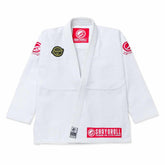Sandbag Training for BJJ: Build Real Grappling Strength
In the dynamic world of combat sports, strength and functional conditioning play a vital role. Strength and functiona conditioning help in determining performance, particularly in grappling-heavy disciplines like Brazilian Jiu-Jitsu (BJJ). Traditional weight training has its merits. However, an increasing number of martial artists are turning to sandbag training. It is a gritty, old-school method—to build raw, real-world strength. In BJJ, grip power, core stability, and awkward body positioning are the norm. So, sandbag training aligns more naturally with the demands of grappling than conventional machines or barbells.
This article explores how sandbag training enhances Brazilian Jiu-Jitsu performance. This will discuss its benefits over traditional lifting. Moreover, this will explore why it is becoming essential not just for BJJ practitioners, but for martial artists of all kinds.
Why Functional Strength Matters in BJJ
Brazilian Jiu-Jitsu (BJJ) is not merely about strength. But it is about using strength intelligently. Unlike bodybuilding, where muscles are often trained in isolation, BJJ involves using multiple muscle groups together under stress. A sweep, a guard pass or securing a submission all require an integration of grip strength, core engagement, explosive hips and isometric control.
This is where sandbag training enters the picture.
Sandbags shift and move, mimicking the resistance of a real human body—especially someone resisting you. This makes it a perfect strength-building tool for those training in Gi or No-Gi BJJ, as the unpredictable load closely resembles the challenges faced during a grappling exchange.
What Is Sandbag Training?
Sandbag training involves lifting, carrying, throwing and manipulating a heavy bag filled with sand. Unlike dumbbells or barbells that have a fixed shape and balanced weight, sandbags are unstable and unbalanced. This instability forces your muscles—especially your core and stabilizers—to work harder to control the movement.
For BJJ athletes, that instability is gold. You are never fighting a static opponent in Jiu-Jitsu. Your training should not be static either.
Benefits of Sandbag Training for Brazilian Jiu-Jitsu
1- Real-World Grip Strength
Sandbags are hard to hold. It does not matter if you are doing carries, cleans or overhead presses. You are forced to constantly readjust your grip. This mimics Gi grips, where holding the lapel or sleeve during a roll requires finger and forearm endurance.
Training with sandbags—especially with a canvas exterior or a Gi-wrapped bag—helps develop the kind of relentless grip strength needed in both Gi and No-Gi Brazilian Jiu Jitsu.
2- Core Stability and Rotational Power
BJJ is a core-dominant sport. Does not matter whether you are shrimping out of side control, rotating to escape back control or bridging for a sweep. Core rotation and stabilization are non-negotiable.
Sandbag exercises like rotational lunges, bear hug carries and shoulder-to-shoulder presses develop rotational core power more effectively than sit-ups ever could. The instability of the sandbag means your core is always engaged, just like in a scramble during a roll.
3- Explosive Power and Conditioning
Sandbag throws, cleans and shouldering movements train explosive hip extension. It is a key movement in BJJ techniques like bridging, takedowns and sweeps. These power-based movements not only build strength. But they also ramp up your cardiovascular conditioning. Thus, replicating the intense bursts of effort required in live sparring or competition.
4- Grip-Integrated Conditioning
A typical BJJ round demands not just muscle endurance but grip endurance. Performing conditioning exercises with a sandbag, like sprint carries or clean-and-press intervals, forces your grip to last under fatigue—just like it would during a long roll in a hot Gi.
5- Improved Functional Movement Patterns
Unlike machines that isolate muscles in perfect alignment, sandbags encourage full-body, compound movement. This reflects the unpredictable nature of martial arts, especially BJJ, where control, resistance and leverage come from all angles.
Training in these natural, chaotic movement patterns builds better athleticism and injury resilience.
Best Sandbag Exercises for BJJ Practitioners
1- Bear Hug Squats
Grab the sandbag tightly in a bear-hug position. Perform controlled squats. This simulates the squeeze strength needed in body locks and takedowns.
2- Sandbag Carries (Shoulder or Bear Hug)
Walking with the sandbag on one or both shoulders—or hugging it to the chest—builds posture, core strength and leg drive, all while hammering your grip.
3- Sandbag Cleans and Shouldering
Lift the sandbag from the ground to your shoulder in one explosive motion, alternating sides. This mimics the explosive hip movement needed for throws and sweeps.
4- Sandbag Get-Ups
It is a variation of the Turkish Get-Up. This move strengthens full-body coordination, core stability and transition control, which are all crucial in scrambling during Jiu-Jitsu.
5- Shoulder-to-Shoulder Presses
Hoist the sandbag from one shoulder to the other repeatedly. This dynamic movement increases shoulder endurance and mimics the twisting core control needed to escape side control or mount.
Sandbag Training vs. Traditional Lifting for Grapplers
Lifting barbells builds maximum strength. However, it often lacks the movement variability and functional application required in BJJ. Machines and isolation lifts build muscle but do not challenge stabilizers or dynamic movement.
Sandbag training, on the other hand, develops “usable strength.” It won’t help you max out on the bench press. But it will help you pass the guard, control the back and finish submissions more effectively.
That said, sandbag training should not necessarily replace all other strength work. Instead, it should supplement your program. Thus, adding the kind of sport-specific chaos that barbell training lacks.
Sandbag Training for Other Martial Arts
While BJJ gets the most benefit from sandbag-style training due to its grappling nature, other martial arts can benefit too:
- Wrestling: Sandbags replicate body lifts and mat returns, improving clinch strength.
- Judo: Clean and throw variations mimic the mechanics of judo throws.
- MMA: Builds total-body endurance and simulates the unpredictable resistance of an opponent.
- Muay Thai/Kickboxing: Shoulder and core work improves clinch control and rotational punching/kicking power.
In each case, the instability and awkwardness of the sandbag help condition fighters for real resistance, not the clean movements of a machine gym.
How to Integrate Sandbag Training into Your BJJ Routine
You do not need to replace your entire strength program with sandbag training. Start by adding 1–2 sandbag workouts per week. Here’s an example:
Sample Sandbag Workout for BJJ (30-40 minutes)
Warm-Up: 5 minutes of jumping jacks, hip openers, and shoulder mobility drills
Circuit (3 rounds):
- 10 Sandbag Cleans
- 8 Bear Hug Squats
- 10 Shoulder-to-Shoulder Presses
- 30-40m Sandbag Carry
- 6 Sandbag Get-Ups (3 each side)
Finisher:
- Max effort Sandbag Burpees for 1 minute
- Rest 1 minute
- Repeat 3 times
End with mobility work and Gi-specific drills for grip and movement transitions.
Guide > BJJ Strength and Conditioning: Best Workouts for Brazilian Jiu Jitsu Athletes
Final Thoughts
In the world of Brazilian Jiu-Jitsu, strength, control, and endurance collide with strategy and timing. Here, sandbag training offers a uniquely effective tool to simulate real-world grappling scenarios. It does not matter if you are training in a BJJ Gi or rolling No-Gi. Adding sandbag workouts to your regimen will build the kind of functional strength that transfers directly to the mat.
So, if you are serious about improving your BJJ game—not just your physique—ditch the chrome and embrace the sand. Because when it comes to dominating positions and resisting fatigue, the unstable load of a sandbag may be your most reliable training partner.







